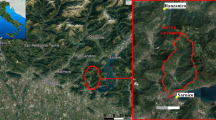Abstract
Specific features of water erosion of thin soils under conditions of nonpercolative water regime and intense recreational loads were studied in the Ol’khon region (Irkutsk oblast). An experiment on the transfer of terrigenous particles under the impact of rainfall simulation was performed. A thorough description of landscape characteristics affecting water erosion development was made. As a result, a multiple regression equation linking the transported matter with the slope steepness, projective cover of vegetation, the degree of vegetation degradation, and the fine sand content in the upper soil horizon was developed; the multiple correlation coefficient R reached 0.86. On this basis, the map of water erosion assessment for the study area was compiled with the use of landscape and topographic maps. The maximum intensity of water erosion is typical of the anthropogenically transformed landscapes on steep slopes with the low vegetative cover on the mountainous noncalcareous steppe soils and on thin loamy sandy surface-gravelly chestnut-like soils.
Similar content being viewed by others
References
E. E. Alberts and F. Ghidey, “Comparison of WEPP model predictions to measured erosion losses for large events,” Eurasian Soil Sci. 30 (5), 564–574 (1997).
B. P. Agafonov, Exolithodynamics of the Baikal Rift Zone (Nauka, Novosibirsk, 1990) [in Russian].
O. I. Bazhenova, E. M. Lyubtsova, Yu. V. Ryzhov, and S. A. Makarov, Spatio-Temporal Analysis of Erosion Dynamics in the South of Eastern Siberia (Nauka, Novosibirsk, 1997) [in Russian].
M. Yu. Belotserkovskii, “Erosion-ecological status of arable lands in European Russia,” in Evaluation of Ecological Burden in Russia: Factors, Zonation, and Consequences (Moscow State Univ., Moscow, 1996), pp. 39–45.
A. F. Vadyunina and Z. A. Korchagina, Field and Laboratory Methods to Study Physical Properties of Soils and Grounds (Vysshaya Shkola, Moscow, 1961) [in Russian].
L. A. Vorob’eva, Chemical Analysis of Soils (Moscow State Univ., Moscow, 1998) [in Russian].
N. Hudson, Soil Conservation (Batsford, London, 1971; Kolos, Moscow, 1974).
V. N. D’yakov, “Anti-erosion efficiency of shelterbelts,” Pochvovedenie, No. 5, 67–71 (1994).
Yu. V. Egorov, A. V. Bobkov, E. N. Esafova, and A. D. Fless, “Installation for determining the solid and liquid runoffs during storm erosion,” Eurasian Soil Sci. 48, 218–222 (2015). doi 10.1134/S1064229315020039
M. V. Zagorskaya, “Landscape structure of Central Priol’khon’e,” Geogr. Prirod. Resur., No. 4, 58–68 (2004).
M. N. Zaslavskii, Erosion Science (Vysshaya Shkola, Moscow, 1983) [in Russian].
M. I. Iveronova, “Movement of surface loose material on vegetated slopes in the forest–meadow-steppe zone of the northern Tien Shan Mountains,” Tr. Inst. Geogr., Akad. Nauk SSSR 75 (6), 26–50 (1959).
A. G. Isachenko, Landscape Science and Physiographic Zonation (Vysshaya Shkola, Moscow, 1991) [in Russian].
N. A. Kachinskii, Mechanical and Microaggregate Analysis of Soils (Moscow State Univ., Moscow, 1958) [in Russian].
L. L. Shishov, V. D. Tonkonogov, I. I. Lebedeva, and M. I. Gerasimova, Classification and Diagnostic System of Russian Soils (Oikumena, Smolensk, 2004) [in Russian].
V. A. Kuz’min, Soils of the Central Zone of Baikal Natural Territory: Ecological and Geochemical Approach (Institute of Geography, Siberian Branch, Russian Academy of Sciences, 2002) [in Russian].
S. B. Kuz’min and L. V. Dan’ko, Paleoecological Models of Ethnonatural Interactions (Geo, Novosibirsk, 2011) [in Russian].
M. I. L’vovich, G. Ya. Karasik, N. L. Brattseva, G. P. Medved’eva, and A. V. Meleshko, The Current Intensity of the Intercontinental Erosion of Terrestrial Globe Land (Nauka, Moscow, 1991) [in Russian].
V. P. Martynov, Soils of Cis-Baikal Mountains (Buryat. Knizhn. Izd., Ulan-Ude, 1965) [in Russian].
A report of the government of Ol’khon district for 2012. http://www.adm-olkhon.ru/news/one-1820.htm
A 2014 report on the results of implementation of the program of social-economic development of Ol’khon district for 2014–2016. http://www.adm-olkhon.ru/ ident01/one-11186.html. Accessed May 5, 2016.
E. A. Ponomarenko and S. V. Solodyankina, “Transformation of coastal geosystems of Baikal Lake affected by recreational activity,” Izv. Irkutsk. Gos. Univ., Ser. Nauki Zemle 6 (1), 147–160 (2013).
I. E. Trofimova, “Cartographic models of climate systems as the information database for balanced territorial development,” Geogr. Prirod. Resur., No. 4, 10–17 (2007).
D. C. Flanagan and J. M. Laflen, “The USDA Water Erosion Prediction Project (WEPP), Eurasian Soil Sci. 30 (5), 524–530 (1997).
A. K. Cherkashin and S. V. Solodyankina, “Modeling of the altitudinal structure of the geomes of the Cis- Baikal region, Geogr. Prirod. Resur., No. 2, 141–148 (2011).
Ecological Planning of Land Use in the Baikal Region: Ol’khonskii District, Ed. by Yu. M. Semenov, et al. (Institute of Geography, Siberian Branch, Russian Academy of Sciences, 2004) [in Russian].
M. E. Grismer, Rainfall simulation studies—a review of designs, performance and erosion measurement variability, 2011. http://ucanr.edu/sites/californiaagriculture/ files/145682.pdf.
M. E. Grismer, “Standards vary in studies using rainfall simulators to evaluate erosion,” Calif. Agric. 66 (3), 102–107 (2012). doi 10.3733/ca.v066n03p102
F. Pirson, J. Williams, and O. Al-Hamdan, Sage STEP Pinyon–Juniper hydrology: implications for rangeland CEAP for rangeland, 2010. http://www. sagestep.org/events/ut_rsch_mtg_10/ppts/Pierson_ Hydro.pdf. Accessed June 6, 2016.
J. V. Vanteeva and S. V. Solodyankina, “Ecosystem functions of steppe landscapes near lake Baikal,” Hacquetia 14 (1), 65–78 (2015). doi 10.1515/hacq-2015- 0016
Author information
Authors and Affiliations
Corresponding author
Additional information
Original Russian Text © T.I. Znamenskaya, J.V. Vanteeva, S.V. Solodyankina, 2018, published in Pochvovedenie, 2018, No. 2, pp. 221–228.
Rights and permissions
About this article
Cite this article
Znamenskaya, T.I., Vanteeva, J.V. & Solodyankina, S.V. Factors of the Development of Water Erosion in the Zone of Recreation Activity in the Ol’khon Region. Eurasian Soil Sc. 51, 221–228 (2018). https://doi.org/10.1134/S1064229318020151
Received:
Published:
Issue Date:
DOI: https://doi.org/10.1134/S1064229318020151




